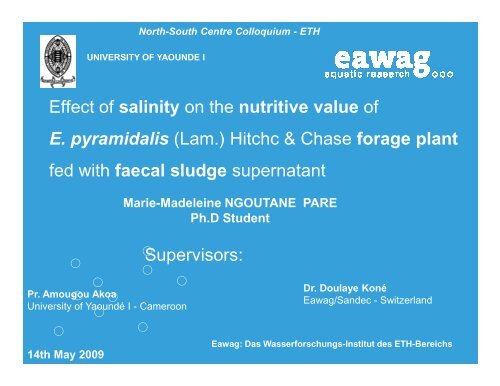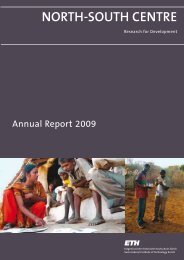Background of the study - ETH - North-South Centre North-South ...
Background of the study - ETH - North-South Centre North-South ...
Background of the study - ETH - North-South Centre North-South ...
Create successful ePaper yourself
Turn your PDF publications into a flip-book with our unique Google optimized e-Paper software.
<strong>North</strong>-<strong>South</strong> <strong>Centre</strong> Colloquium - <strong>ETH</strong><br />
UNIVERSITY OF YAOUNDE I<br />
Effect <strong>of</strong> salinity on <strong>the</strong> nutritive value <strong>of</strong><br />
E. pyramidalis (Lam.) Hitchc & Chase forage plant<br />
fed with faecal sludge supernatant<br />
Marie-Madeleine NGOUTANE PARE<br />
Ph.D Student<br />
Supervisors:<br />
Pr. Amougou Akoa<br />
University <strong>of</strong> Yaoundé I - Cameroon<br />
Dr. Doulaye Koné<br />
Eawag/Sandec - Switzerland<br />
14th May 2009<br />
Eawag: Das Wasserforschungs-Institut des <strong>ETH</strong>-Bereichs
Outline<br />
1. Introduction<br />
<strong>Background</strong> <strong>of</strong> <strong>the</strong> <strong>study</strong><br />
Research hypo<strong>the</strong>sis<br />
Aims <strong>of</strong> <strong>the</strong> <strong>study</strong><br />
2. Materials and methods<br />
3. Results and discussion<br />
4. Conclusion<br />
20/05/2009 2
<strong>Background</strong> <strong>of</strong> <strong>the</strong> <strong>study</strong><br />
Influence <strong>of</strong> climate change on <strong>the</strong> natural<br />
resources :<br />
1. Rapid growth rate <strong>of</strong> urban population;<br />
2. Increasing food demand.<br />
Food security is an important issue.<br />
20/05/2009 3
<strong>Background</strong> <strong>of</strong> <strong>the</strong> <strong>study</strong><br />
• Many resources are wasted in cities<br />
• Failure in water and sanitation provision<br />
• Malfunctioning <strong>of</strong> wastewater treatment<br />
systems in Africa and Asia :<br />
Lack <strong>of</strong> financial and human resources for<br />
operation and maintenance (Koné, 2002).<br />
20/05/2009 4
<strong>Background</strong> <strong>of</strong> <strong>the</strong> <strong>study</strong><br />
Introduction<br />
• Link sanitation infrastructure and cities<br />
economic development<br />
Encourage reuse <strong>of</strong> nutrients and water;<br />
Couple agricultural system and sanitation<br />
technology<br />
=> CLOSE THE LOOP<br />
20/05/2009 5
<strong>Background</strong> <strong>of</strong> <strong>the</strong> <strong>study</strong><br />
Introduction<br />
Constructed wetland (CW)<br />
=> Biomass productions<br />
=> Valuable opportunities:<br />
• Producing safe forage;<br />
• Recycling wastewater;<br />
• Providing long-term sustainable source <strong>of</strong> income<br />
for covering treatment plant Operation &<br />
Maintenance cost<br />
20/05/2009 6
<strong>Background</strong> <strong>of</strong> <strong>the</strong> <strong>study</strong><br />
Introduction<br />
Echinochloa pyramidalis (Lam.) Hitchc & Chase (Poaceae)<br />
Grows in humid environment<br />
Forage plant<br />
Originates from tropical Africa<br />
Widely distributed in tropical regions<br />
20/05/2009 7
<strong>Background</strong> <strong>of</strong> <strong>the</strong> <strong>study</strong><br />
Introduction<br />
Echinochloa pyramidalis (Lam.) Hitchc & Chase (Poaceae)<br />
• High potential to treat wastewater and human excreta;<br />
• High yielding potential in CW (Kengne et al. 2008)<br />
⇒ New perspectives for producing forage from<br />
wastewater and faecal sludge treatment (Koné, 2007).<br />
20/05/2009 8
<strong>Background</strong> <strong>of</strong> <strong>the</strong> <strong>study</strong><br />
Introduction<br />
• Demand for livestock products increases <strong>of</strong> 3 % per<br />
year in sub-Saharan African<br />
• Forage availability for urban and peri-urban dairy<br />
system is steadily decreasing (Rischkowsky et al., 2006)<br />
⇒ Acute shortage <strong>of</strong> forage (seasonal fluctuation)<br />
⇒ Low quality <strong>of</strong> forage<br />
• Spread <strong>of</strong> dairy enterprises in <strong>the</strong> urban centers<br />
=> <strong>the</strong> demand <strong>of</strong> forage plant has been increasing<br />
• Both dry and fresh E. pyramidalis are marketed<br />
=> opportunity to generate incomes for operational and<br />
maintenance <strong>of</strong> sanitation infrastructure<br />
20/05/2009 9
<strong>Background</strong> <strong>of</strong> <strong>the</strong> <strong>study</strong><br />
Introduction<br />
Question:<br />
Does E. pyramidalis tolerate <strong>the</strong> salinity <strong>of</strong><br />
faecal sludge ?<br />
• In Cameroon: wide variations in <strong>the</strong> composition <strong>of</strong><br />
faecal sludge with high salt contents.<br />
• Similar concentrations to those <strong>of</strong> o<strong>the</strong>r sub-Saharan<br />
countries like Burkina-Faso, Ghana (Koné et al., 2004).<br />
20/05/2009 10<br />
• The conductivity <strong>of</strong> faecal sludge from <strong>the</strong> Yaoundé<br />
urban areas varied from 0.7 to 15 mS/cm.
Research hypo<strong>the</strong>sis<br />
Introduction<br />
High salt content <strong>of</strong> faecal sludge has an<br />
effect on E. pyramidalis, in particular:<br />
Its nutrient content<br />
Its cell-wall composition<br />
Mineral composition<br />
20/05/2009 11
Goal <strong>of</strong> <strong>the</strong> <strong>study</strong><br />
Introduction<br />
Evaluate <strong>the</strong> effect <strong>of</strong> salt stress on <strong>the</strong> nutritive<br />
value <strong>of</strong> E. pyramidalis<br />
Parameters under <strong>study</strong>:<br />
Crude protein content;<br />
Cell-wall composition : NDF, ADL, ADF<br />
Mineral composition :<br />
Na + , Ca 2+ , Mg 2+ , K + , Cl - and SO<br />
2-<br />
4<br />
20/05/2009 12
Location <strong>of</strong> <strong>the</strong> <strong>study</strong> sites<br />
Yaoundé<br />
20/05/2009 13
Materials & Methods<br />
Experimental unit for salinity trials<br />
20/05/2009 14
Materials & Methods<br />
Experimental design:<br />
24 small-scale units <strong>of</strong> VFCW with a capacity <strong>of</strong> 50 L<br />
and a section <strong>of</strong> 0.78 m 2 ;<br />
randomly divided flooded and non-flooded conditions.<br />
20/05/2009 15
Materials & Methods<br />
Planting<br />
Young shoots collected in <strong>the</strong> natural wetlands,<br />
with 20 cm <strong>of</strong> length<br />
Were planted at a density <strong>of</strong> seven plants per<br />
bed.<br />
Acclimatization<br />
Beds were flooded with raw wastewater<br />
(EC< 2000 µS/cm) to about 5 cm above <strong>the</strong><br />
gravel layer, for 8 weeks.<br />
20/05/2009 16
Materials & Methods<br />
Salinity experiment – Feeding <strong>of</strong> experimental units<br />
• Twice a week with 15 L <strong>of</strong> faecal sludge (FS) supernatant<br />
• Four different salinity level:<br />
(EC = 2000, 3000, 6000, 9000 µS/cm)<br />
And a control (< 2000µS/cm).<br />
Salinity level = Salinity in Faecal sludge supernatant + KCl +<br />
Ca(NO 3 ) 2 + Na 2 SO 4<br />
20/05/2009 17<br />
=> Salts added to obtain <strong>the</strong> desired electrical<br />
conductivity
Materials & Methods<br />
Characteristics <strong>of</strong> applied faecal sludge<br />
supernatant :<br />
• Redox potential (9.4 to 27.6 mV)<br />
• Salts: anions (NO 3- , Cl - , SO 4<br />
2-<br />
) and<br />
cations (Na + , Ca 2+ , Mg 2+ , K + )<br />
• Total nitrogen<br />
• pH neutral<br />
20/05/2009 18
Materials & Methods<br />
• Plant sampling<br />
Harvest at two different periods (45 and 100 days)<br />
Plants were cut at 20 cm above <strong>the</strong> sand level and<br />
divided into leaves and stems.<br />
• Plant Analysis<br />
Water content<br />
20/05/2009 19
Materials & Methods<br />
Chemical analyses<br />
Total N determined by Kjeldahl procedure (AOAC, 2000);<br />
Crude Protein (CP) calculated as N×6.25;<br />
Acid Detergent Fiber (ADF) (AOAC, 2000);<br />
Neutral Detergent Fiber (NDF) and sulfuric Acid<br />
Detergent Lignins (ADL) ( Van Soest et al., 1991)<br />
20/05/2009 20
Materials & Methods<br />
Mineral analyses<br />
Flame photometer<br />
for Na + , Ca 2+ , Mg 2+ , K +<br />
Spectrophotometer<br />
for Chloride (Cl-).<br />
20/05/2009 21
Results and discussion<br />
Effect <strong>of</strong> salinity on <strong>the</strong> water content <strong>of</strong> <strong>the</strong> forage stems<br />
Treatment period<br />
= 45 days<br />
Treatment period<br />
= 100 days<br />
Results and discussion<br />
Effect <strong>of</strong> salinity on <strong>the</strong> water content <strong>of</strong> <strong>the</strong> forage leaves<br />
Treatment period<br />
= 45 days<br />
Results and discussion<br />
45 and 100 days treatment:<br />
• Increase <strong>of</strong> salinity => Decrease <strong>of</strong> water content in<br />
leaves and stems<br />
• Plant water content in flooded condition
Results and discussion<br />
Crude Protein (CP):<br />
• In leaves => 11-18 % DM<br />
• In stems => 7-16 % DM<br />
• CP decreases as salinity increases<br />
• Significant reduction at 6000 and 9000 µS/cm<br />
• No difference between flooded and free drainage<br />
conditions<br />
• No difference between 45 and 100 days <strong>of</strong> salt<br />
treatment<br />
20/05/2009 25<br />
=> Values in <strong>the</strong> stems and leaves are above <strong>the</strong><br />
minimum requirement (6-8 % DM) for livestock<br />
productions and proper ruminant-bacteria functioning
Results and discussion<br />
Cell-wall content (ADF, ADL (sa), NDF)<br />
• 45 and 100 days treatment<br />
LEAVES:<br />
ADF varied from 27- 38 % DM<br />
ADL from 8-14 % DM<br />
NDF from 58- 75 % DM<br />
Values in <strong>the</strong> control are higher<br />
STEMS:<br />
Values higher than in <strong>the</strong> leaves.<br />
• No significant difference between <strong>the</strong> control and<br />
o<strong>the</strong>r treatments for ADF, ADL (sa)<br />
20/05/2009 26<br />
• Significant difference between <strong>the</strong> control and<br />
o<strong>the</strong>r treatments
Results and discussion<br />
Mineral composition<br />
• No difference between 45 and 100 days<br />
• No difference between flooded and free drainage conditions<br />
• Range within <strong>the</strong>se concentrations (g / 100g DW):<br />
Mg 2+ : 0.17 - 0.21<br />
K + : 0.5 – 1.0<br />
Na + : 0.01 – 0.25<br />
Ca 2+ : 0.17 – 1.53<br />
=> Meet <strong>the</strong> requirements for animal nutrition<br />
20/05/2009 27
Conclusion<br />
Quality <strong>of</strong> cell-wall constituents <strong>of</strong> E. pyramidalis<br />
were improved in <strong>the</strong> salt affected vertical-flow<br />
constructed wetlands;<br />
Leaves are richer in nutrients than stems<br />
Salt stress did not have any impact on mineral<br />
uptake;<br />
=> Salt stress did not lead to mineral deficiencies.<br />
Crude protein value <strong>of</strong> <strong>the</strong> plants was higher in<br />
<strong>the</strong> constructed wetland than in Nature<br />
20/05/2009 28
Conclusion<br />
Rapid growth rate<br />
High biomass production<br />
High protein content<br />
Ability to maintain <strong>the</strong> nutritive potential under saline<br />
conditions<br />
=> E. pyramidalis is appropriate for constructed<br />
wetlands treatment<br />
20/05/2009 29<br />
=> Constructed wetlands can be adapted to<br />
producing high nutritive forage plant !
Conclusion<br />
Fur<strong>the</strong>r investigations are needed:<br />
• Evaluation <strong>of</strong> forage intake and digestibility<br />
• Hygienic quality and safety<br />
• Plant management, harvest times<br />
20/05/2009 30
Acknowledgemements<br />
• Swiss Federal Institute <strong>of</strong> Aquatic Sciences and<br />
Technology (Eawag), Department <strong>of</strong> Water and<br />
Sanitation in Developing Countries (Sandec),<br />
• Commission for Research Partnerships with<br />
Developing Countries (KFPE)<br />
• International Foundation for Science for <strong>the</strong>ir financial<br />
and logistical support (IFS, Sweden grant N° W/4262-<br />
1)<br />
20/05/2009 31
THANK YOU FOR YOUR ATTENTION !<br />
20/05/2009 32<br />
Fur<strong>the</strong>r information:<br />
marie-madeleine.ngoutane@eawag.ch
















